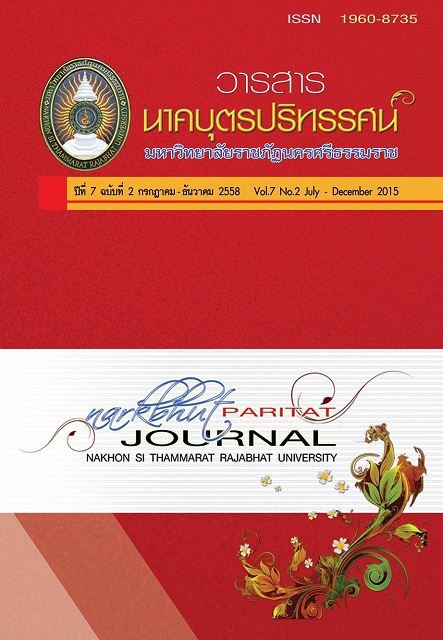การใช้แหล่งการเรียนรู้ในท้องถิ่นประกอบการจัดการเรียนการสอนในสถานศึกษาขั้นพื้นฐานสังกัดสำนักงานเขตพื้นที่การศึกษาประถมศึกษาสุราษฎร์ธานี เขต 2
Main Article Content
Abstract
การวิจัยครั้งนี้ มีวัตถุประสงค์เพื่อศึกษาและเปรียบเทียบการใช้แหล่งการเรียนรู้ในท้องถิ่น ประกอบการจัดการเรียนการสอนของสถานศึกษาขั้นพื้นฐาน สังกัดสำนักงานเขตพื้นที่การศึกษาประถมศึกษา สุราษฎร์ธานี เขต 2 เก็บรวบรวมข้อมูลจากผู้บริหารสถานศึกษา 35 คน และครูผู้สอน จำนวน 285 คน รวม 320 คน โดยใช้แบบสอบถามที่มีค่าเชื่อมั่น 0.90 วิเคราะห์ข้อมูลโดยใช้สถิติพื้นฐาน ได้แก่ ค่าเฉลี่ย ค่าส่วนเบี่ยงเบนมาตรฐาน สถิติทดสอบ ได้แก่ การทดสอบที และทดสอบเอฟ ผลการวิจัยพบว่า การใช้แหล่งการเรียนรู้ในท้องถิ่นประกอบการจัดการเรียนการสอนโดยรวมอยู่ในระดับปานกลาง เรียงลำดับจากมากไปหาน้อย ดังนี้ แหล่งการเรียนรู้ประเภทวัฒนธรรม ประเพณีท้องถิ่น มีค่าเฉลี่ยสูงกว่าด้านอื่น รองลงมาคือ แหล่งการเรียนรู้ประเภทสถานที่ ประเภทเอกสาร สิ่งพิมพ์ เทคโนโลยี ประเภททรัพยากรธรรมชาติ และ ประเภทบุคคล มีค่าเฉลี่ยต่ำกว่าด้านอื่น ผลการเปรียบเทียบการใช้แหล่งการเรียนรู้ จำแนกตามตำแหน่ง หน้าที่ที่ปฏิบัติ ระดับการศึกษา ประสบการณ์ในการสอน ระดับชั้นที่สอน และขนาดของสถานศึกษา พบว่า ระดับการศึกษา ระดับชั้นที่สอน และขนาดของสถานศึกษา โดยภาพรวมแตกต่างกันอย่างมีนัยสำคัญทางสถิติที่ระดับ 0.05 ส่วนตำแหน่งหน้าที่ที่ปฏิบัติ และประสบการณ์ในการทำงานไม่แตกต่างกัน
Using Local Learning Source for Instructional Preparation of Basic Education Schools under Suratthani Primary Educational Service Area Office 2
The purpose of this research was to study and compare using learning source in local for instructional preparation of Basic Educational Schools under Suratthani Educational Service Area Office 2. The data was collected from 320 people; 35 administrators and 285 teachers. Questionnaire was used with a reliability of 0.90. Statistics used for data analysis were mean, standard deviation, t - test and F - test statistics. The results of research found that using learning sources in locality for instructional preparation in overall were at moderate level ordered from the highest to the lowest level respectively. That is to say culture, local traditional learning sources were at higher rate than others. Secondly, places, documents, technologies and personal were at lower rate than others. The comparative results on using learning sources in locality divided as the position, educational level and grades of instruction. Educational level, grades of instruction and size of school were statistically significant different at 0.05 level. The position and work experience were not different.

